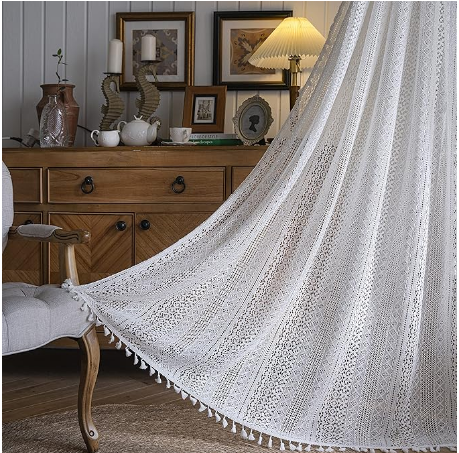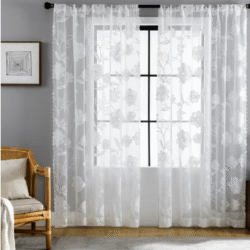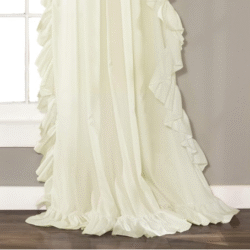cotton lace curtains….Victorian lace curtains are a timeless and elegant addition to any home, offering a perfect blend of beauty, intricacy, and functionality. Originating in the Victorian era, these delicate curtains were not just decorative elements but also a statement of sophistication and class. With their intricate lace patterns and light, airy fabric, Victorian lace curtains provide a sense of privacy while allowing soft natural light to filter into the room. They evoke a sense of nostalgia, reflecting the grandeur of the 19th century, and continue to be a popular choice for those looking to add a vintage touch to their decor. Whether draping over windows in a traditional setting or blending with modern interior styles, Victorian lace curtains are a versatile and enduring choice for any home.
The History and Origins of Victorian Lace Curtains
The history and origins of Victorian lace curtains are deeply rooted in the cultural and social changes of the 19th century. During the Victorian era, which spanned from 1837 to 1901 under Queen Victoria’s reign, there was a growing emphasis on home decoration, particularly among the middle and upper classes. Lace curtains, with their intricate designs and delicate texture, became an essential element in the fashionable homes of the time.
Lace itself has a long history, but it reached its peak of popularity during the Victorian period. The Victorians were enamored with fine craftsmanship and intricate detail, and lace curtains perfectly reflected these values. They were often handmade, using techniques such as needlepoint lace and bobbin lace, which required skilled artisans. Lace curtains were not only ornamental but also functional, allowing for privacy while still letting in soft natural light.
The Victorian love for opulence and elegance also influenced the designs of these curtains. Patterns ranged from floral motifs to geometric shapes, and the sheer nature of the fabric allowed them to blend seamlessly with the heavy, dark furnishings typical of Victorian interiors. By the late 19th century, lace curtains became a symbol of refinement and wealth, decorating windows in both modest homes and grand estates. Today, Victorian lace curtains continue to evoke nostalgia and are cherished for their timeless beauty and historical significance.
Key Features of Victorian Lace Curtains
- Intricate Designs: Victorian lace curtains feature elaborate, detailed patterns, often with floral or geometric motifs.
- Delicate Fabric: Made from fine, lightweight materials such as cotton, linen, or silk, creating a soft and airy texture.
- Sheer Transparency: These curtains allow natural light to filter through while providing privacy.
- Handcrafted Quality: Many Victorian lace curtains were handwoven or hand-stitched, showcasing the craftsmanship of the era.
- Ornamental Functionality: They combine beauty with practicality, offering both decorative appeal and light control.
- Elegant Appearance: Victorian lace curtains add a sense of sophistication and refinement to any room.
- Variety of Styles: Available in different lengths and designs, including full window panels, valances, and tiebacks.
- Historical Significance: Symbolize the opulence and attention to detail of the Victorian era.
- Classic Textures: The use of different lace-making techniques such as bobbin lace and needlepoint lace adds texture and depth.
- Timeless Appeal: Still highly regarded today for their vintage charm and ability to complement both traditional and modern interiors.
How Victorian Lace Curtains Enhance Home Décor
- Adds Elegance: Victorian lace curtains bring a touch of sophistication and timeless beauty to any room.
- Softens Natural Light: The delicate fabric allows light to filter through, creating a soft, ambient glow in the room.
- Vintage Charm: These curtains evoke a sense of nostalgia and classic style, making them perfect for vintage or retro-inspired décor.
- Versatile Style: They complement both traditional and modern interiors, blending seamlessly with various design themes.
- Enhances Privacy: While allowing light to pass through, lace curtains provide privacy without blocking the view entirely.
- Textural Contrast: The intricate lace patterns add texture and depth, balancing other design elements in the room.
- Feminine Touch: The delicate, feminine quality of lace curtains can soften the overall look of a room, making it feel cozy and inviting.
- Rich Detailing: The fine craftsmanship and detailed patterns of Victorian lace elevate the aesthetic of windows, creating a focal point in the room.
- Complementary to Heavy Furnishings: Their light, airy nature contrasts beautifully with the heavier, darker furniture typical of Victorian décor.
- Timeless Appeal: Victorian lace curtains never go out of style, ensuring they continue to enhance the décor for years to come.
Types of Lace Used in Victorian Curtains
- Bobbin Lace: A popular lace type made by twisting threads around bobbins, creating intricate, delicate patterns, often used in Victorian curtains.
- Needlepoint Lace: Created using a needle to stitch intricate patterns, often featuring floral or geometric designs, widely used in Victorian-era lace curtains.
- Chemical Lace: A machine-made lace that mimics the appearance of handmade lace, often used for more affordable Victorian lace curtains.
- Carrickmacross Lace: A combination of applique and netting techniques, used to create elegant, detailed lace patterns for curtains.
- Honiton Lace: Known for its fine quality and floral patterns, often featured in more luxurious Victorian lace curtains.
- Crochet Lace: A handmade lace made with crochet hooks, providing a textured and intricate design that was commonly used in Victorian home décor.
- Tape Lace: Made by sewing narrow strips of tape to form a lace pattern, this style was used in various Victorian lace curtain designs.
- Point de Venise Lace: A rich, detailed lace often used for high-end Victorian curtains, characterized by its thick, raised patterns and intricate stitching.
- Guipure Lace: A heavier lace with no netting, typically used for more decorative and durable Victorian curtains.
- Filet Lace: Featuring open spaces within a grid, this type of lace was used to create unique, geometric or floral patterns for Victorian curtains.
Victorian Lace Curtains in Modern Interiors
Victorian lace curtains, though rooted in the 19th century, continue to find their place in modern interiors, offering a beautiful blend of vintage charm and contemporary design. Today, they are appreciated for their timeless elegance and versatility, seamlessly blending with both traditional and modern décor styles. In modern interiors, these delicate curtains often serve as a striking contrast to minimalist or industrial designs, softening harsh lines and adding warmth and texture to the space.
The sheer fabric of Victorian lace curtains allows natural light to filter through, creating a serene, inviting atmosphere without sacrificing privacy. This balance makes them ideal for rooms that benefit from soft illumination, such as living rooms, dining areas, and bedrooms. In spaces with contemporary furniture, Victorian lace curtains can add a sense of history and character, enhancing the room’s overall aesthetic.
Moreover, the intricate lace patterns, whether floral or geometric, provide a touch of sophistication that complements modern color palettes, such as muted tones or monochrome schemes. In addition to their decorative value, these curtains also have a functional role, offering an elegant way to diffuse light while maintaining privacy. Whether used in a vintage-inspired room or paired with sleek modern pieces, Victorian lace curtains continue to be a favored choice for adding timeless beauty and a touch of the past to today’s interiors.
Caring for and Maintaining Victorian Lace Curtains
- Gentle Washing: Hand wash Victorian lace curtains with mild detergent or dry clean them to avoid damaging the delicate fabric.
- Avoid Harsh Chemicals: Use non-abrasive cleaning products to preserve the integrity of the lace and prevent discoloration.
- Cold Water Only: Wash lace curtains in cold water to prevent shrinkage and to maintain the fabric’s texture.
- Air Drying: Always air dry Victorian lace curtains by hanging them up, as high heat can cause them to lose their shape or weaken the threads.
- Ironing Carefully: Iron on a low heat setting, or place a cloth over the lace to avoid direct contact with the iron and prevent damage.
- Regular Dusting: Dust lace curtains regularly with a soft brush or vacuum with a fabric attachment to keep them free from dirt and debris.
- Avoid Direct Sunlight: Prolonged exposure to direct sunlight can cause the fabric to fade, so it’s best to keep lace curtains out of intense sun for extended periods.
- Storage: When not in use, store Victorian lace curtains in a cool, dry place, and consider using fabric bags to protect them from dust and pests.
- Repairs: Immediately repair any tears or loose threads to prevent further damage and preserve the curtain’s beauty.
- Proper Hanging: Use light curtain rods or hooks to prevent undue stress on the lace fabric and ensure it hangs gracefully.
conclusion
In conclusion, cotton lace curtains offer a perfect blend of elegance, practicality, and timeless beauty. With their delicate texture and intricate patterns, they continue to be a beloved choice for enhancing home décor. Whether used to add a vintage charm to traditional settings or to soften the look of modern interiors, cotton lace curtains provide a versatile and enduring solution for light control and privacy. Their natural fabric ensures durability and ease of maintenance, making them a functional as well as stylish addition to any room. As a symbol of refinement and craftsmanship, cotton lace curtains remain a cherished element of home design, continuing to captivate with their beauty and timeless appeal.



